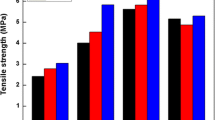Abstract
This paper describes the utilisation of urea as a single chemical agent to obtain deproteinised high ammoniated natural rubber latex (HA-NRL). The role of urea in HA-NRL deproteinisation was further investigated by employing two different concentrations of urea solution which are low (0.01–0.05%) and high (1.0–5.0%) concentrations. The study assessed the potential usage of urea as a single denaturing agent in the presence of neither stabilising agent nor additives during the deproteinisation process. The effect of different urea concentrations on properties of deproteinised NRL was further scrutinised by using sodium dodecyl sulphate–polyacrylamide gel electrophoresis (SDS-PAGE), nitrogen content analysis, extractable protein (EP) content, Zeta potential, attenuated total reflection-Fourier transform infrared (ATR-FTIR) spectroscopy and physical strength. The presence of residual urea is pertinent as the concentration of urea increases while contributing to the increase of total nitrogen content in the resultant film. Leaching the film with hot water is sufficient to remove the residual urea as supported by an ATR-FTIR analysis. Initial exploratory data analysis of low and high urea concentrations on the effect of nitrogen content, EP, surface charge properties of latex and green strength of the deproteinised NRL were evaluated and their relation to each factor was further discussed. Based on the initial findings, urea was observed to be less effective as a single denaturant. Nonetheless, the properties of the deproteinised HA-NRL treated with urea were revealed to be markedly influenced by the urea concentration.





Similar content being viewed by others
References
Palosuo T (2014) Chemistry, manufacture and applications of natural rubber national institute for health and welfare. Woodhead Publishing Limited, Finland, pp 452–482
Sussman GL, Beezhold DH, Kurup VP (2002) Allergens and natural rubber proteins. J Allergy Clin Immunol 110(2):s33–s39
Sansatsadeekul Jitlada, Sakdapipanich Jitladda, Rojruthai Porntip (2011) Characterization of associated proteins and phospholipids in natural rubber latex. J Biosci Bioeng 111(6):628–634
Kawahara Y, Klinklai S, Kuroda W, Isono H (2004) Removal of proteins from natural rubber with urea”. Polym Adv Technol 15(4):181–184
Creighton TE (1984) Proteins: structures and molecular principles in protein structure determination, suelter, ch edn. Wiley, New York, p 514
Greene RF, Pace CN (1974) Urea and guanidine hydrochloride denaturation of ribonuclease, lysozyme, zhymotrypsin, and lactoglobulin. J Biol Chem 249(17):5388–5393
Pace CN (1986) Determination and analysis of urea and guanidine hydrochloride denaturation curves. Methods Enzymol 131:266–280
Kauzmann W (1959) Some factors in the interpretation of protein denaturation. Adv Protein Chem 14:1–63
Yamamoto PT, Kawahara Y, Chaikumpollert S, Nghia O (2013) Protein-free natural rubber, latex thereof, and method for manufacturing said rubber. US patent no. 8476348
Bennion BJ, Daggett V (2003) The molecular basis for the chemical denaturation of proteins by urea. pnas 100(9):5142–5147
Creighton TE (1995) Protein folding: an unfolding story. Curr Biol 5(4):353–356
Lindgren M (2010) On the mechanism of urea-induced protein denaturation master dissertation. University Of Umea, Sweeden
Creighton TE (1979) Electrophoretic analysis of the unfolding of proteins by urea. J Mol Biol 129(2):235–264
Yamamoto Y, Nghia PT, Klinklai W, Saito T, Kawahara S (2008) Removal of proteins from natural rubber with urea and its application to continuous processes. J Appl Polym Sci 107:2329–2332
Ariyawiriyanana W, Nuinua J, Sae-Hengb K, Kawahara S (2013) The mechanical properties of vulcanized deproteinized natural rubber. Energy Proced 34:728–733
Nawamawat K, Sakdapipanich JT, Chee CH, Ma Y, Song J, Vancso JG (2011) Surface nanostructure of Hevea brasiliensis natural rubber latex particles. Colloids Surf A Physicochem Eng Aspects 390:157–166
Kemp AR, Straitiff WG (1940) Hevea latex: effect of proteins and electrolytes on colloidal behavior. J Phys Chem 44(6):788–800
Blackley DC (1997) Chemically-modified lattices: 1. Prevulcanized lattices, chap. 13, polymer latices science and technology, vol. 2: type of lattices, 2nd edn. Chapman and Hall, London
Shigeyuki T, Che J, Rong L, Hsiao BS, Amnuaypornsri S, Adul Nimpaiboon, Sakdapipanich J (2013) Entanglements and networks to strain-induced crystallization and stress-strain relations in natural rubber and synthetic polyisoprene at various temperatures. Macromolecules 46:5238–5248
Acknowledgements
The authors would like to thank the Director General of the Malaysian Rubber Board for permission to publish the findings of this study. The assistance rendered by Ahmad Shawal Razlan, Zuliza Ahmad, Ahmad Syaheer Abu Aswad, and Syamimi Izzati Mohd Asri is highly acknowledged. Technical and scientific English editing by respective editors and reviewers are most appreciated.
Author information
Authors and Affiliations
Corresponding author
Ethics declarations
Conflict of interest
The authors declare that they have no conflict of interest.
Additional information
Publisher's Note
Springer Nature remains neutral with regard to jurisdictional claims in published maps and institutional affiliations.
Rights and permissions
About this article
Cite this article
Nurulhuda, A., Aziana, A.H., Norazreen, A.R. et al. Urea as a single denaturing agent in deproteinisation of natural rubber latex. J Rubber Res 22, 99–107 (2019). https://doi.org/10.1007/s42464-019-00016-9
Received:
Accepted:
Published:
Issue Date:
DOI: https://doi.org/10.1007/s42464-019-00016-9




